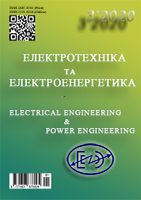Development of ideas about "bias current"
DOI:
https://doi.org/10.15588/1607-6761-2020-3-1Abstract
Purpose. In electrical engineering, radio engineering, such concepts as charge, electric field, magnetic field, electromagnetic field, direct electric current, alternating current are used. These abstract concepts reflect certain real physical phenomena. For example, current is understood as the directed movement of electric charges. However, there is also a conditionally abstract concept of "bias current", which was introduced by Maxwell to explain the passage of current through a section of capacitor where there are no charges. The purpose of the article is to reveal the substantive meaning of this term and to explain the real mechanism of current flow in an electric circuit.
Methodology. Analysis of the phenomenon is performed on the basis of such traditional concepts as charge, electric field, magnetic field, electromagnetic field, direct electric current, alternating current. Analysis of the contradiction between the concept of current as a directed movement of charges and the concept of "bias current" as a current without charges is presented. Theoretical coordination of the "bias current "concepts and current as a directed motion of charges is done.
Findings. It is shown that for all sections of a closed electric circuit, the definition of current as a directed movement of charges is valid only for direct current, when the charges are actually moving in all sections of the circuit. In the circuit with the capacitor, direct current does not flow, because there are no charges in the gap between the plates of the capacitor. However, alternating current occurs, at the moment when the circuit is closed. In the area of the conductor there is a directed movement of charges and the cause of the movement is an electric field, which is variable and occurs together with the alternating magnetic field in all parts of the circuit, including the part of the capacitor where there are no charges. It is shown that in general the concept of current as a directed motion of charges is correct, but conditionally abstract, because in fact the root cause is what is called an electromagnetic field. The concept of bias current is a conditionally abstract expression of the electromagnetic field.
Originality. The novelty is that it is possible to understand adequately and non-abstractly the processes that occur in an electric circuit during the passage of current, that no current creates an electric field around the conductor on which charges move, and vice versa, alternating electric field leads to charges ,which are in the conductor areas.
Practical value. Understanding the real essence of the term makes it possible to assess correctly the processes occurring in the electrical circuit; gives the answer whether the movement of charges occurs gradually or immediately around the circle when connecting an e.r.s. and closing the circuit. This understanding gives you an idea of what happens when the capacitor electrodes are connected to an e.r.s. and why do the electrons in a conductor come in a directed motion, what is the nature of the force acting on the electrons.
References
Savel'ev, I.V. (1978). Kurs obshhej fiziki. Vol. 2, Moscow, Nauka, 110.
Kingsep, A.S., Lokshin, G.R., Ol'xov, O.A. (2007). Kurs obshhej fiziki. Uchebnoe posobie dlya vuzov, Vol. 1, Moscow, FIZMATLIT, 244.
Butikov, E.I. (1986). Optika. Moscow, Vysshaya shkola, 512.
Fizicheskij e'nciklopedicheskij slovar' (1983). Moscow, Sov. e'nciklopediya, 507.
Hans, C. (1988). Physics second edition, expandet. Rensselaer politedinic institute. W.w.Norton & company, New York, London, 971-972.
Aleshkevich, V.A. (2010). Kurs obshhej fiziki. Optika. Moscow, FIZMATLIT, 7.
Fejnman, R., Lejton, R., Sends, M. (1966) Fejnmanovskie lekcii po fizike. Vol. 6, Moscow, Mir, 119.
Hans, C. (1988). Physics second edition, expandet. Hans C. Ohanian. Rensselaer politedinic institute. W.w.Norton & company. New York, London, 971-972.
Sus', B.A., Sus', B.B., Kravchenko, O.B. (2012). Unusual interpretation of traditional physics problems. The third scientific-methodological edition. Kyiv, PC Prosvita, 121.
Paul, A. Tipler, (2008). Gene Moska. Physics for scientists and engineers. With modern physics. New York, 1029.
Roumond, A. Serway, John W.Jewett. (2018). Physics forScientists and Engineers. 955.
Sivuxin, D.V. (1977). Kurs obshhej fiziki. T. 3. E'lek-trichestvo. Moscow, Nauka, 347.
Kalashnikov, S.G. (1985). E'lektrichestvo. Moscow, Nauka, 285.
Kalitievskij, N.I. (1978). Volnovaya optika. Moscow, Vysshaya shkola, 11.
Karpov, Ya.S., Kisel'nik, V.V., Kremen', V.G. (2004). Koncepcії suchasnogo prirodoz-navstva. Kyiv: Profesіonal, 171.
Yavorskij, B.M., Detlaf, A.A. (1963). Spravochnik po fizike. Moscow, GIFML, 119.
Downloads
Published
How to Cite
Issue
Section
License

This work is licensed under a Creative Commons Attribution 4.0 International License.
Creative Commons Licensing Notifications in the Copyright Notices
Authors who publish with this journal agree to the following terms:
Authors retain copyright and grant the journal right of first publication with the work simultaneously licensed under aCreative Commons Attribution License that allows others to share the work with an acknowledgement of the work's authorship and initial publication in this journal.
Authors are able to enter into separate, additional contractual arrangements for the non-exclusive distribution of the journal's published version of the work (e.g., post it to an institutional repository or publish it in a book), with an acknowledgement of its initial publication in this journal.
Authors are permitted and encouraged to post their work online (e.g., in institutional repositories or on their website) prior to and during the submission process, as it can lead to productive exchanges, as well as earlier and greater citation of published work.

